- Joined
- Apr 14, 2013
- Messages
- 2,677
- Reaction score
- 2,044
- Location
- India
- Can others edit my Photos
- Photos OK to edit
Hello everyone, it's been a while since I've been around, and a lot of new faces. 
I'm participating in the Sanctuary asia wildlife photography competition, and need to submit 5 images. I have shortlisted three, but can't decide 2 among 8. Looking for some opinions - Since the judging will also be based on the circumstances and species, I have added some details.
Please choose 2 from the 8.
1. Snowflake Morey
About 20 inches long, these eccentric species, despite how they look, are very hardy and can inflict serious bites. These are sought after by hobbyists for their aquarium, and have been known to survive upto 4 years in man made conditions. They prefer to hunt at night as they have poor eyesight, like most other morey, but a great sense of smell. They spend the day time hiding in rocks and crevices.
Snowflake eels are protogynous, so the more dominant eel in the group will change from female to male. Snowflake eels are egg scatterers that produce eggs often in midwater mating rituals. Their eggs and larvae drift with plankton in the water column and settle back onto a reef at about the time of hatching. Snowflake eels are among the most challenging types of marine fish to propagate in captivity.

2. Pregnant Male - Banded Pipefish
Banded pipefish are also IUCN “data deficient” species – meaning not too much is known about their conservation status and are tricky to identify. They are usually about 15 cm long, with an elongated body, and patterns helping them to hide among reefs.
The male pipefish, is equipped with the brood pouch, where the female deposits her eggs and leaves it to develop, as seen in the image with the eggs under the belly.
The male later gives birth to the offsprings.
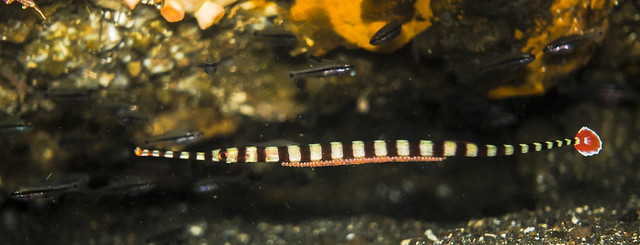
3. Juvenile porcelain anemone crab (not real crab)
Porcelain crabs can grow upto 15mm, the one in the image is a juveline is only about 3 mm in size.
They are quite fragile, and can shed their limbs to escape predators. The large claws, which can regrow, is not used for hunting but for territorial battles.
These crabs are not real crabs, but relatives of squat shrimps. They hide under rocks or anemones for protection from predators.
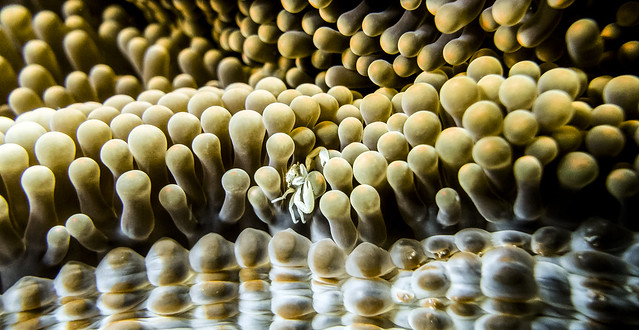
4. Garden Eels
These small eels, growing upto 60 cms, live in burrows on the sea floor and get their name from their practice of poking their heads from their burrows while most of their bodies remain hidden. Since they tend to live in groups, the many eel heads "growing" from the sea floor resemble the plants in a garden.
Their diet consists of zooplankton it picks from the current as it flows past. For this reason, all the eels in a colony generally face the same direction: into the current, and look as if they are dancing with the current. These creatures, with a conservation status in IUCN - "not evaluated", make burrows in sands using their saliva, and barely ever leave. They quickly retract themselves, tail first, into its burrow if threatened.
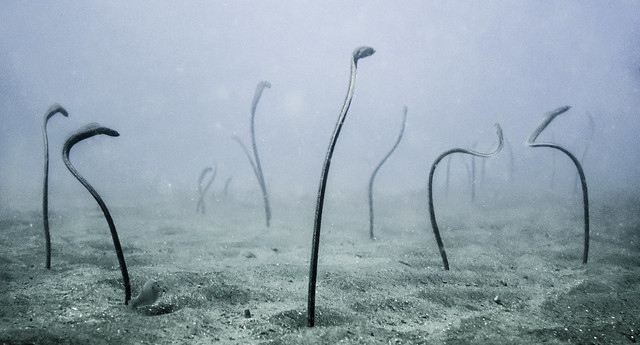
Nothing special to write about these:
5. Green Turtle
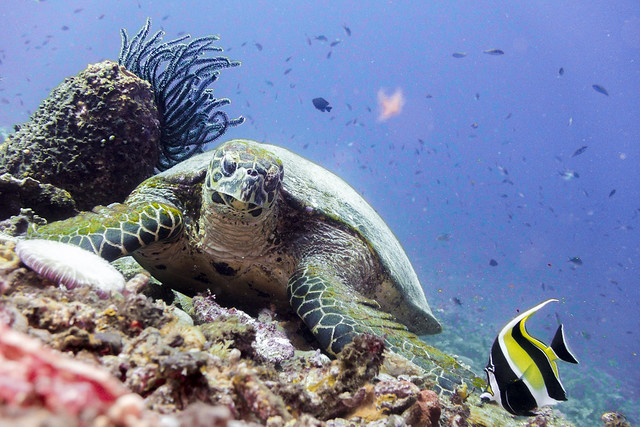
6. Cuttle fish
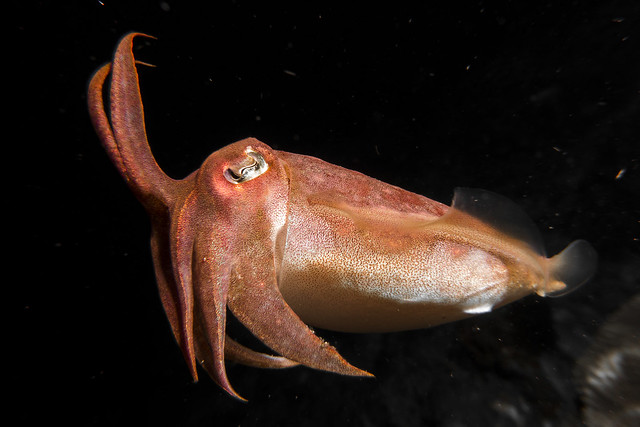
7. Cuttle fish

8. Star of the show
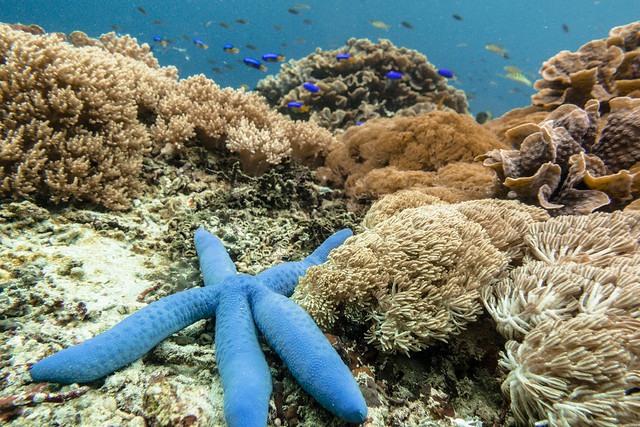
_________________These are the one's I've already selected____________________
1. Denise’s pigmy sea horse
This 2cm long creature spends its entire life hiding in a specific gorgonian, and use adaptive camouflage changing its color and texture to match the surrounding gorgonians. They feed on small planktons. This male in the image is pregnant, and will give birth to the babies soon.
The species is relatively rare, classified as “data deficient” by IUCN, and extremely difficult to spot due to their incredibly small size.
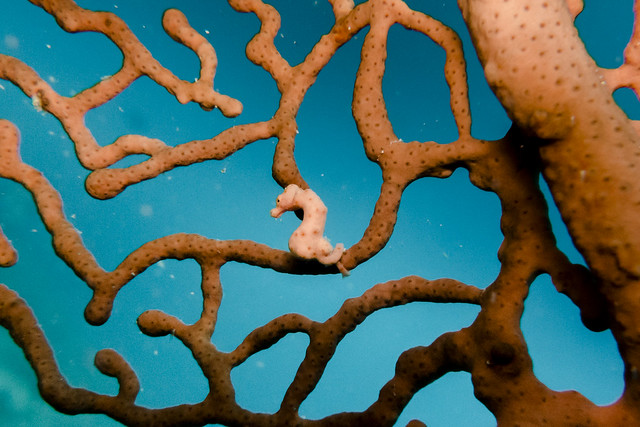
2. Nudibranch/Sea slug
Mating behavior, taken in Amed, Indonesia.
Nudibranch, while in the their larval stage, usually have a shell, similar to other gastropods.
These have poor eyesights, and rely on their rhinopores and oral tentacles to feel the world. These carnivorous creatures are picky carnivores, individual species usually hunting one particular type of food. The flamboyant coloration warns their predators to stay away, or die of poisoning. Depending on the species, they either make their own toxin, or acquire them from their toxic food. They are hermaphrodites, and engage in this mating ritual to fertilize each other’s future generation slugs.

3. Bargibant's Pigmy Seahorse
This 2cm long creature spends its entire life hiding in a specific gorgonian, and use adaptive camouflage changing its color and texture to match the surrounding gorgonians. They feed on small planktons. This male (in focus) in the image is pregnant, and will give birth to the babies soon. The female can be seen nearby although out of focus.So effective is this camouflage that the species wasn’t actually discovered until its host gorgonian was being examined in a laboratory
The species is relatively rare, classified as “data deficient” by IUCN, and extremely difficult to spot due to their incredibly small size.
Image taken in padangbai Indonesia.
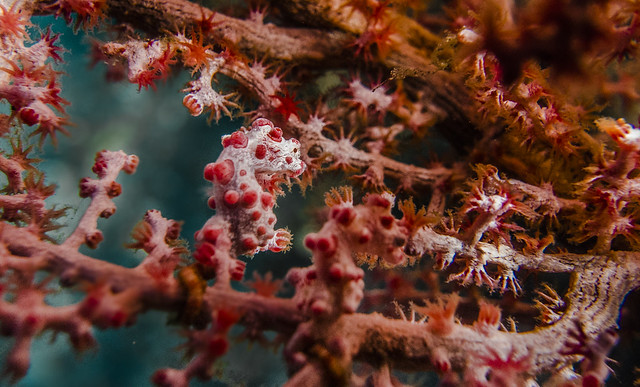
I'm participating in the Sanctuary asia wildlife photography competition, and need to submit 5 images. I have shortlisted three, but can't decide 2 among 8. Looking for some opinions - Since the judging will also be based on the circumstances and species, I have added some details.
Please choose 2 from the 8.
1. Snowflake Morey
About 20 inches long, these eccentric species, despite how they look, are very hardy and can inflict serious bites. These are sought after by hobbyists for their aquarium, and have been known to survive upto 4 years in man made conditions. They prefer to hunt at night as they have poor eyesight, like most other morey, but a great sense of smell. They spend the day time hiding in rocks and crevices.
Snowflake eels are protogynous, so the more dominant eel in the group will change from female to male. Snowflake eels are egg scatterers that produce eggs often in midwater mating rituals. Their eggs and larvae drift with plankton in the water column and settle back onto a reef at about the time of hatching. Snowflake eels are among the most challenging types of marine fish to propagate in captivity.

2. Pregnant Male - Banded Pipefish
Banded pipefish are also IUCN “data deficient” species – meaning not too much is known about their conservation status and are tricky to identify. They are usually about 15 cm long, with an elongated body, and patterns helping them to hide among reefs.
The male pipefish, is equipped with the brood pouch, where the female deposits her eggs and leaves it to develop, as seen in the image with the eggs under the belly.
The male later gives birth to the offsprings.

3. Juvenile porcelain anemone crab (not real crab)
Porcelain crabs can grow upto 15mm, the one in the image is a juveline is only about 3 mm in size.
They are quite fragile, and can shed their limbs to escape predators. The large claws, which can regrow, is not used for hunting but for territorial battles.
These crabs are not real crabs, but relatives of squat shrimps. They hide under rocks or anemones for protection from predators.

4. Garden Eels
These small eels, growing upto 60 cms, live in burrows on the sea floor and get their name from their practice of poking their heads from their burrows while most of their bodies remain hidden. Since they tend to live in groups, the many eel heads "growing" from the sea floor resemble the plants in a garden.
Their diet consists of zooplankton it picks from the current as it flows past. For this reason, all the eels in a colony generally face the same direction: into the current, and look as if they are dancing with the current. These creatures, with a conservation status in IUCN - "not evaluated", make burrows in sands using their saliva, and barely ever leave. They quickly retract themselves, tail first, into its burrow if threatened.

Nothing special to write about these:
5. Green Turtle

6. Cuttle fish

7. Cuttle fish

8. Star of the show

_________________These are the one's I've already selected____________________
1. Denise’s pigmy sea horse
This 2cm long creature spends its entire life hiding in a specific gorgonian, and use adaptive camouflage changing its color and texture to match the surrounding gorgonians. They feed on small planktons. This male in the image is pregnant, and will give birth to the babies soon.
The species is relatively rare, classified as “data deficient” by IUCN, and extremely difficult to spot due to their incredibly small size.

2. Nudibranch/Sea slug
Mating behavior, taken in Amed, Indonesia.
Nudibranch, while in the their larval stage, usually have a shell, similar to other gastropods.
These have poor eyesights, and rely on their rhinopores and oral tentacles to feel the world. These carnivorous creatures are picky carnivores, individual species usually hunting one particular type of food. The flamboyant coloration warns their predators to stay away, or die of poisoning. Depending on the species, they either make their own toxin, or acquire them from their toxic food. They are hermaphrodites, and engage in this mating ritual to fertilize each other’s future generation slugs.

3. Bargibant's Pigmy Seahorse
This 2cm long creature spends its entire life hiding in a specific gorgonian, and use adaptive camouflage changing its color and texture to match the surrounding gorgonians. They feed on small planktons. This male (in focus) in the image is pregnant, and will give birth to the babies soon. The female can be seen nearby although out of focus.So effective is this camouflage that the species wasn’t actually discovered until its host gorgonian was being examined in a laboratory
The species is relatively rare, classified as “data deficient” by IUCN, and extremely difficult to spot due to their incredibly small size.
Image taken in padangbai Indonesia.

Last edited:













